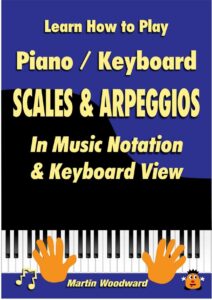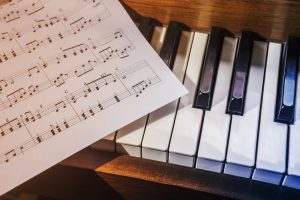Table of Contents
Playing the piano improves the brain and brain activity
According to neuroscientist Gottfried Lau, there is no other art that involves as much brain activity as playing a musical instrument, and we are not specifically talking about child prodigies . The question we should ask ourselves then is rather which areas of the brain are not active when playing an instrument.

Best Sheet Music download from our Library.
Over the years, scientists have been advancing their knowledge of the brains of musicians through studies carried out using MRIs and CT scans. These consist of recording in real time the brains of some musicians while they play their instrument. In them they have been able to corroborate that this activity involves almost all areas of the brain simultaneously, especially the auditory, motor and sensory cortex . Furthermore, it has been discovered that musicians have certain areas that are more developed, larger than and those who are not. A larger area implies a greater number of fibers or nerve connections, which allows us to infer that there is greater communication between its different regions in this type of brain.
How playing an instrument benefits your brain – Anita Collins

More developed areas in the brain of musicians
It has been discovered that some of the most developed areas in the brain of musicians are: the cerebellum, responsible for the movements of muscle fibers throughout the body, the corpus callosum, which connects both hemispheres and the central fissure, which is believed establishes the dominance of the skilled hand in every person.
Please, subscribe to our Library.
If you are already a subscriber, please, check our NEW SCORES’ page every month for new sheet music. THANK YOU!
There are many articles written about what makes the brains of guitarists and drummers unique, however playing the piano is something completely different and much more challenging. No drum kit has a distinction of tones due to its composition nor does it allow chords to be played, so these are not issues to take into account when performing them. For its part, the guitar only allows you to play six notes at a time and mostly requires great skill in the left hand. On the other hand, pianists (it has also been said about piano tuners ) can play up to ten notes at the same time with both hands, create chords and differentiate tones, so it is logical that to handle all these options they need to develop completely unique brain capacities. that are already being revealed by science.

It has been discovered that some of the most developed areas in the brain of musicians are:
- The cerebellum, responsible for the movements of muscle fibers throughout the body
- The corpus callosum, which connects both hemispheres
- The central fissure, which is believed to establish the dominance of the skilled hand in every person
In the case of pianists, studies have shown that their brains are the ones that present the greatest modifications outside the average. This is almost evident since the piano is the instrument par excellence in terms of skill demand : pianists must read notes, feel the keys, move their fingers and hands through 88 possible notes and hear what is being played. And as if this were not enough, they must do it all at the same time!
The Brains of Musicians – Dr. Ellen Winner on Neuroplasticity
The Piano: The instrument that demands the most on the brain
So it is expected that these musicians will have a more developed corpus callosum since they need to coordinate the movements of the left and right hands at the same time and connect the creative part of the right hemisphere with the mathematics of the left to control timing. Furthermore, since they require both hands to be equally active, pianists have to overcome an innate quality for almost all people: being right- or left-handed. It is known that in most people the depth of the central fissure or Rolando’s fissure is greater in one of the two hemispheres, either the right or the left, which determines which hand will be dominant in that person.
But when scanning the brains of the pianists, the scientists found something different: they actually had central grooves that were much more symmetrical than anyone else — even though they were born right- or left-handed, in their brains this was barely perceptible. Given that despite this, pianists still have a dominant hand, researchers speculate that this symmetry in depth is not natural but the result of these musicians being able to strengthen their weaker side until it approximately coincides with the dominant side.
This has sparked intense debates in the world of neuroscience and music, leading scientists to wonder if there is a certain basic structural difference in the brains of musicians or if it is shaped through musical learning.
Studies in children who are just starting out in music have shown that the hearing areas are more active after a year of musical training than in those who have not learned to play any instrument. However, this position is not accepted by all neuroscientists, including Ellen Winner , who maintains that these children have had structurally different brains since birth.
These scientists also maintain that discipline and practice are what strengthen certain brain circuits and thus their functions, thus allowing attention and strength to be applied in other activities. To prove this, Dr. Timo Krings conducted research in which he scanned the brains of pianists while they performed a solo and found that they pumped less blood than the average person in the region of the brain associated with fine motor skills. This change in blood flow implies that this area requires less energy to carry out its normal functioning, which allows them to free themselves from the task they are executing to concentrate their attention on other aspects that are totally unique, such as their own and very personal way of interpreting. every melody.
Although these changes in blood flow occur in anyone who masters a skill, in pianists this efficiency of their brain is developed through modifications in the central sulcus and some alterations in the functions of the frontal lobe. This is something really impressive since the frontal lobe is responsible for integrating information from the outside along with decision making. This sector of the brain plays an essential role in problem solving, language, spontaneity, decision making and social behavior.
Another study associated with this topic is that of Dr. Ana Pinho in which it was discovered that when experienced pianists play, the part of their brain associated with giving stereotyped responses literally turns off, which would explain why each professional pianist develops a style of interpretation that is his own.
Conclusion
Although it seems like a cliché as a result of these studies, we can conclude that it is true that the brain has a great capacity for adaptation and that it also maintains its plasticity throughout a person’s life, but for this to happen it has to constantly face the challenge to learn new things; even more so if the activity to be learned is playing an instrument and even more so if it is the piano. And as music teacher Shinichi Suzuki maintained, in the right environment and with enough practice, anyone can become an excellent musician.
Your brain on music | Alan Harvey | TEDxPerth
Neuroscientist and musician Alan Harvey takes us on an interactive journey showing live on stage what music does to our brain waves, and explains how music is more than just an entertainment. You’ve never seen music like this before… Alan is joined by fellow neuroscientist Andrew Price and musicians from Perth Symphony Orchestra led by Bourby Webster.
Alan’s main experimental neuroscience interests are in trauma, transplantation, gene therapy and regeneration, his research primarily focused on understanding the growth of circuits in the visual system and spinal cord, and how best to protect and repair these circuits after injury. He is passionate about music, and over the past half-century he has performed in choirs, as a solo artist and in various folk and rock bands.
In 2017, his book “Music, Evolution, and the Harmony of Souls” was published by Oxford University Press, bringing together his musical and neuroscientific interests, exploring music throughout human evolution and emphasising its importance for human welfare. This talk was given at a TEDx event using the TED conference format but independently organized by a local community. Learn more at https://www.ted.com/tedx
Browse in the Library:
Or browse in the categories menus & download the Library Catalog PDF:
